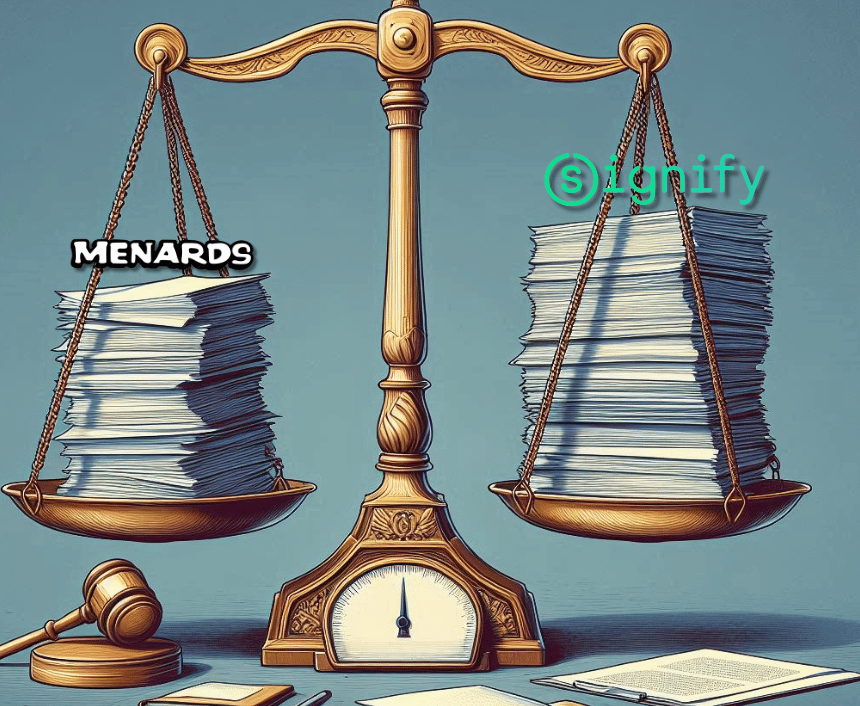Most companies end up settling out of Court with Signify. Not Menard, they continue to fight as they respond to Signify’s motion to strike expert testimony. Henrik Villumsen of the Villumsen Law Firm reminded your humble editor that these continuous back-and-forth filings with expert witnesses must be getting very expensive.
In the ongoing case at the United States District Court for the Western District of Wisconsin, Signify North America Corporation has filed a lawsuit against Menard, Inc., with Menard subsequently implicating Luminex International Company, Ltd., among others, as third-party defendants. The case, identified as Case No. 22-cv-00706-jdp, involves allegations of patent infringement and is now proceeding with a jury trial.
Overview of the Case
Signify North America Corporation alleges that Menard, Inc. has infringed on multiple patents related to lighting technology. Menard, in turn, has brought third-party claims against Luminex International Company, Ltd., and other entities, seeking indemnification and contribution regarding the alleged infringements.
Recent Developments
The recent court activity focuses on the plaintiffs’ motion to strike portions of Menard’s and the third-party defendants’ non-infringement rebuttal expert reports. The motion addresses several patents, including the ‘604, ‘506, ‘336, ‘554, ‘643, and ‘399 patents, all central to the dispute. The plaintiffs argue that the rebuttal reports introduce new claim constructions not previously disclosed, thereby prejudicing their case.
Key Arguments and Legal Standards
- Introduction of New Claim Constructions: Signify argues that the non-infringement rebuttal reports by Menard and the third-party defendants’ experts introduce new claim constructions, which should be struck down. They assert that these new constructions were not part of the initial claim construction exchange and thus are untimely and prejudicial.
- Defendant’s Rebuttal: Menard and the third-party defendants contend that their experts’ reports do not introduce new claim constructions. They argue that their experts’ opinions are consistent with the legal standard of applying the understanding of a person of ordinary skill in the art (POSITA). The reports merely respond to the plaintiffs’ infringement allegations based on the plain and ordinary meaning of the disputed terms.
- Specific Patent Claims Addressed:
- ’604 Patent: Dr. Curran’s rebuttal report for the ’604 patent did not introduce new claim constructions. It responded to the plaintiffs’ expert’s interpretation, debating whether the preamble of claim 1 should be considered limiting and the proper construction of the “means for activation” term.
- ’506 and ’336 Patents: Dr. Eden’s report for these patents responded to the plaintiffs’ claims by applying the plain and ordinary meaning to terms like “cove member” and “interior surface” in the ’506 patent. It also addressed the preamble of claim 13 in the ’336 patent.
- ’554, ’643, and ’399 Patents: Dr. Peter Shackle’s report addressed the terms “without monitoring or regulating a first voltage or a first current” and “alternating current (A.C.) power source that provides signals other than a standard A.C. line voltage,” applying their plain and ordinary meanings.
- Legal Standards Referenced:
- Plain and Ordinary Meaning: The court’s scheduling order stipulates that any term not identified for construction will be given its plain and ordinary meaning.
- Rule 702: Permits experts to testify in the form of an opinion if their knowledge will help the trier of fact understand the evidence or determine a fact in issue.
Expert Commentary by Dr. Peter Shackle
Dr. Peter Shackle, a leading expert in lighting technology, provided significant insights in his rebuttal report. He emphasized the importance of understanding the plain and ordinary meaning of the terms used in the patents.
“In my opinion, a person of ordinary skill in the art (POSITA) would understand the term ‘without monitoring or regulating a first voltage or a first current’ to mean exactly that – no monitoring or regulating of the specified voltage or current,” said Dr. Shackle. He further explained that this interpretation aligns with the intrinsic evidence found in the patent specifications.
Dr. Shackle also addressed the term “alternating current (A.C.) power source that provides signals other than a standard A.C. line voltage,” stating, “A POSITA would understand this to mean that the power source must provide signals different from the standard A.C. line voltage. This is crucial in determining non-infringement because the accused products must be evaluated based on these specific definitions.”
Regarding the “alternating current (A.C.) dimmer circuit” term, Dr. Shackle commented, “The plain and ordinary meaning here is that the dimmer circuit should be capable of providing signals other than a standard A.C. line voltage. This understanding is consistent with both the technical field and the disclosures within the patent documents.”
Conclusion and Anticipated Outcomes
Menard and the third-party defendants urge the court to deny Signify’s motion to strike. They argue that their experts’ reports comply with established legal standards. The resolution of this motion will significantly impact the presentation of evidence and arguments at trial.






